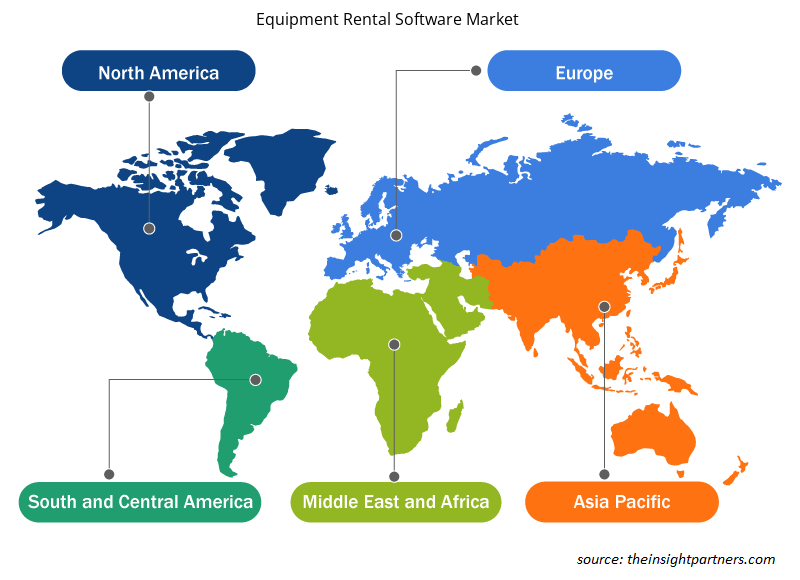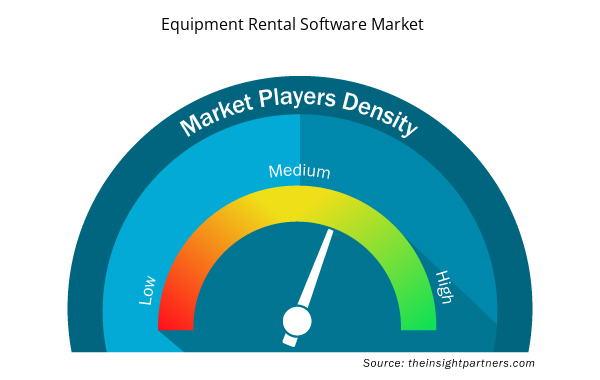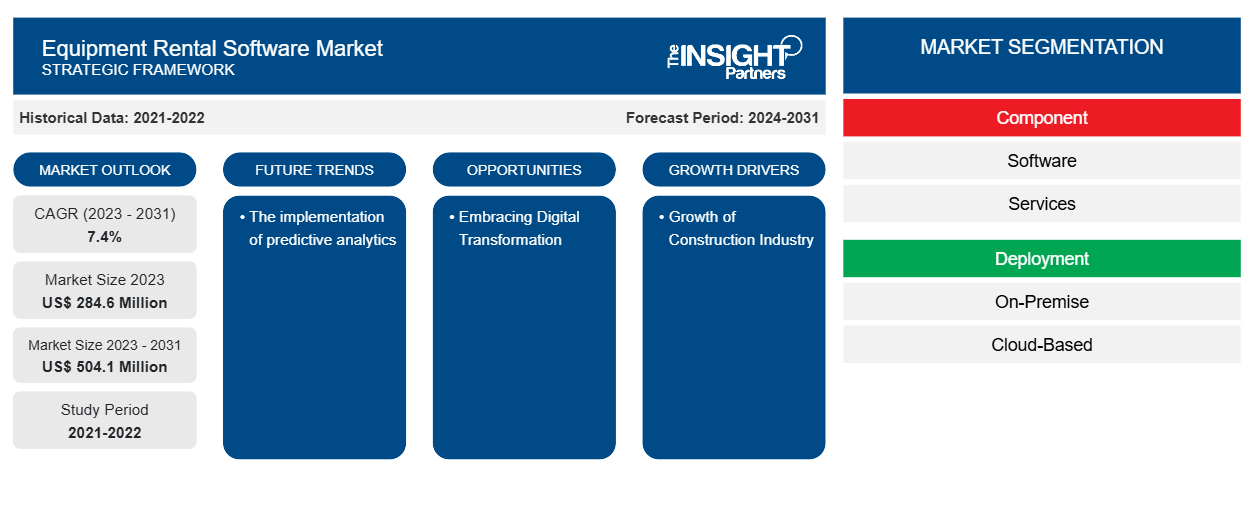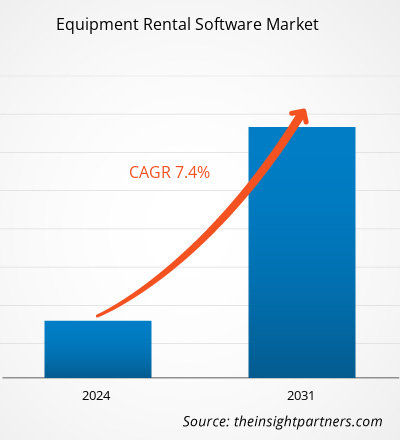Si prevede che la dimensione del mercato del software per il noleggio di attrezzature raggiungerà i 504,1 milioni di dollari entro il 2031, rispetto ai 284,6 milioni di dollari del 2023. Si prevede che il mercato registrerà un CAGR del 7,4% nel periodo 2023-2031. È probabile che l'implementazione dell'analisi predittiva rimanga una tendenza chiave nel mercato.CAGR of 7.4% during 2023–2031. The implementation of predictive analytics is likely to remain a key trend in the market.
Analisi di mercato del software per il noleggio di attrezzature
Il software per il noleggio di attrezzature è progettato per utilizzare in modo efficiente le risorse disponibili, assicurando al contempo che ogni aspetto dell'attività sia coperto, dalla formazione e assistenza clienti alla produttività e gestione finanziaria. Lo scopo del software per il noleggio di attrezzature è quello di aiutare a gestire la flotta di attrezzature di proprietà di un'organizzazione. Questo software può apportare vantaggi a un'organizzazione oltre a sapere cosa è disponibile e dove si trova il noleggio. Un software per il noleggio di attrezzature potente consentirà a un'organizzazione di fare quanto segue e di raccogliere i benefici. Il vantaggio di tutte queste funzionalità, nel complesso, è un aumento della produttività e della redditività. La differenza tra un buon software per il noleggio di attrezzature e il miglior software per il noleggio di attrezzature è la profondità e l'usabilità delle sue funzionalità. HBS Systems va oltre le funzionalità di base del software per il noleggio di attrezzature con una serie di funzionalità aggiuntive che possono essere utilizzate ovunque su dispositivi mobili in un unico sistema facile da usare .
Panoramica del mercato del software per il noleggio di attrezzature
Il software di noleggio attrezzature fornisce alle aziende strumenti per semplificare i processi, organizzare le operazioni, gestire le risorse e calcolare l'ammortamento. Utilizzando questa soluzione software, è anche possibile assegnare attrezzature ai dipendenti, pianificare la manutenzione ed eseguire operazioni di back-office come contabilità e tenuta dei registri contabili. Il software di noleggio attrezzature può aiutare il mercato medio e le piccole imprese in rapida crescita a raggiungere i propri obiettivi aziendali e a crescere attraverso vantaggi quali la riduzione dei tempi di fermo delle attrezzature, l'organizzazione delle pianificazioni, la generazione di report e approfondimenti, la gestione di fatture e documenti e altro.
Personalizza questo report in base alle tue esigenze
Riceverai la personalizzazione gratuita di qualsiasi report, comprese parti di questo report, o analisi a livello nazionale, pacchetto dati Excel, oltre a usufruire di grandi offerte e sconti per start-up e università
- Scopri le principali tendenze di mercato in questo rapporto.Questo campione GRATUITO includerà analisi di dati che spaziano dalle tendenze di mercato alle stime e alle previsioni.
Driver e opportunità del mercato del software per il noleggio di attrezzature
Crescita del settore delle costruzioni per favorire il mercato
I progetti di investimento pubblico stanno dando una grande spinta al settore edile. Ciò include mega-progetti in settori quali infrastrutture urbane, trasporti, strade, irrigazione e immobiliare. L'Autorità aeroportuale indiana sta investendo 7,3 miliardi di dollari nella costruzione di nuovi aeroporti, nell'ampliamento e nell'ammodernamento di quelli esistenti e nel rafforzamento di piste, blocchi tecnici e torri di controllo. Amplierà inoltre i tre aeroporti PPP di Delhi, Bengaluru e Hyderabad, con un investimento di 3,59 miliardi di dollari entro il 2025. Il software di noleggio di attrezzature edili per l'industria dei materiali da costruzione garantisce una soluzione affidabile e sicura che soddisfi le esigenze dei clienti. Con funzionalità specifiche quali prezzi delle attrezzature industriali, manutenzione preventiva, gestione dei numeri di serie e moduli di riparazione, Sirius-e è stato progettato per soddisfare tutte le esigenze del noleggio di utensili e attrezzature. La capacità di Sirius-e di gestire noleggi, vendite e assistenza in un unico software di noleggio integrato porterà notevoli vantaggi alla tua attività di noleggio edile.PPP airports in Delhi, Bengaluru, and Hyderabad, with an investment of US $3.59 billion by 2025. Construction material industry construction equipment rental software ensures that you have a reliable and reliable solution that meets clients' needs. With specific features such as industrial equipment pricing, preventive maintenance, serial number management, and repair modules, Sirius-e was designed to meet all the needs of tool and equipment rental. Sirius-e’s ability to handle rentals, sales, and service all in one integrated rental software will bring significant benefits to your construction rental business.
Abbracciare la trasformazione digitale
L'avvento delle tecnologie digitali offre opportunità senza precedenti alle aziende di noleggio di attrezzature per semplificare le operazioni, migliorare le esperienze dei clienti e guidare la crescita. L'adozione di iniziative di trasformazione digitale, come sistemi di gestione del noleggio basati su cloud, tracciamento delle attrezzature abilitato per IoT e applicazioni mobili per l'interazione con i clienti, consente alle aziende di rimanere all'avanguardia. Sfruttando l'analisi dei dati e le informazioni predittive, le aziende possono ottimizzare l'allocazione delle risorse, anticipare le esigenze dei clienti e prendere decisioni aziendali informate. Microsoft Dynamics 365 Business Central può essere una soluzione preziosa per le aziende di noleggio di attrezzature, fornendo una piattaforma integrata per gestire in modo efficiente vari aspetti delle loro operazioni aziendali.IoT-enabled equipment tracking, and mobile applications for customer engagement, enables businesses to stay ahead of the curve. By leveraging data analytics and predictive insights, businesses can optimize resource allocation, anticipate customer needs, and make informed business decisions. Microsoft Dynamics 365 Business Central can be a valuable solution for equipment rental companies, providing an integrated platform to manage various aspects of their business operations efficiently.
Analisi della segmentazione del rapporto di mercato del software per il noleggio di attrezzature
I segmenti chiave che hanno contribuito alla derivazione dell'analisi di mercato del software per il noleggio di attrezzature sono i componenti, l'implementazione, le dimensioni dell'organizzazione e l'utente finale.
- In base alla componente, il mercato del software per il noleggio di attrezzature si divide in software e servizi.
- In base all'implementazione, il mercato è segmentato in on-premise e basato su cloud.
- In base alle dimensioni dell'organizzazione, il mercato è segmentato in piccole e medie imprese e grandi imprese.
- In termini di utenti finali, il mercato è segmentato in produzione, edilizia, trasporti e altri.
Analisi della quota di mercato del software per il noleggio di attrezzature per area geografica
L'ambito geografico del rapporto di mercato del software per il noleggio di attrezzature è principalmente suddiviso in cinque regioni: Nord America, Asia Pacifico, Europa, Medio Oriente e Africa e Sud e Centro America. Le crescenti attività di costruzione in Nord America e la crescente necessità di operazioni efficienti tra le aziende stanno guidando la crescita del mercato. Vari attori in Nord America stanno lanciando software per il noleggio di attrezzature. Ad esempio, a settembre 2020, Orion Software ha annunciato un accordo con Telus per vendere e commercializzare la tecnologia GPS per integrare i suoi servizi di noleggio. Le società di noleggio possono utilizzare la piattaforma Sirius e per aggiornare i loro contatori in tempo reale, fatturando l'eccesso di utilizzo e attivando avvisi di manutenzione preventiva. Il portale Web del portale clienti può anche localizzare le attrezzature sul campo in un cantiere. Questa integrazione con la tecnologia Telus offre un significativo vantaggio di distribuzione. Le società di noleggio possono ottenere una tecnologia standard che funziona su tutte le marche di attrezzature ed è molto semplice da installare.Telus to sell and commercialize GPS technology to supplement its rental services. Rental companies can use the Sirius e platform to update their meters in real time, invoicing overuse and triggering preventive maintenance alerts. The customer portal's web portal can also locate equipment in the field on a construction site. This integration with Telus technology provides a significant deployment benefit. Rental companies can get a standard technology that works on all equipment brands and is very simple to install.
Approfondimenti regionali sul mercato del software per il noleggio di attrezzature
Le tendenze regionali e i fattori che influenzano il mercato del software per il noleggio di attrezzature durante il periodo di previsione sono stati ampiamente spiegati dagli analisti di Insight Partners. Questa sezione discute anche i segmenti e la geografia del mercato del software per il noleggio di attrezzature in Nord America, Europa, Asia Pacifico, Medio Oriente e Africa e America meridionale e centrale.

- Ottieni i dati specifici regionali per il mercato del software di noleggio attrezzature
Ambito del rapporto di mercato sul software per il noleggio di attrezzature
| Attributo del report | Dettagli |
|---|---|
| Dimensioni del mercato nel 2023 | 284,6 milioni di dollari USA |
| Dimensioni del mercato entro il 2031 | 504,1 milioni di dollari USA |
| CAGR globale (2023-2031) | 7,4% |
| Dati storici | 2021-2022 |
| Periodo di previsione | 2024-2031 |
| Segmenti coperti | Per componente
|
| Regioni e Paesi coperti | America del Nord
|
| Leader di mercato e profili aziendali chiave |
|
Densità dei player del mercato del software per il noleggio di attrezzature: comprendere il suo impatto sulle dinamiche aziendali
Il mercato del software per il noleggio di attrezzature sta crescendo rapidamente, spinto dalla crescente domanda degli utenti finali dovuta a fattori quali l'evoluzione delle preferenze dei consumatori, i progressi tecnologici e una maggiore consapevolezza dei vantaggi del prodotto. Con l'aumento della domanda, le aziende stanno ampliando le loro offerte, innovando per soddisfare le esigenze dei consumatori e capitalizzando sulle tendenze emergenti, il che alimenta ulteriormente la crescita del mercato.
La densità degli operatori di mercato si riferisce alla distribuzione di aziende o società che operano in un particolare mercato o settore. Indica quanti concorrenti (operatori di mercato) sono presenti in un dato spazio di mercato in relazione alle sue dimensioni o al valore di mercato totale.
Le principali aziende che operano nel mercato del software per il noleggio di attrezzature sono:
- BCS Prosoft, LLC
- Prenotabile eSlJB Inc.
- Noleggio EZ
- Software di noleggio HQ
- inspHire Ltd.
- Società anonima
Disclaimer : le aziende elencate sopra non sono classificate secondo un ordine particolare.

- Ottieni la panoramica dei principali attori del mercato del software per il noleggio di attrezzature
Notizie e sviluppi recenti sul mercato del software per il noleggio di attrezzature
Il mercato del software per il noleggio di attrezzature viene valutato raccogliendo dati qualitativi e quantitativi dopo la ricerca primaria e secondaria, che include importanti pubblicazioni aziendali, dati associativi e database. Di seguito sono elencati alcuni degli sviluppi nel mercato del software per il noleggio di attrezzature:
- EZRentOut ha introdotto una serie di nuove funzionalità e miglioramenti. Gli affitti alle aziende sono semplificati con il modulo di gestione dei clienti B2B. I clienti possono ora utilizzare un pulsante Quick Check-in per resi più rapidi ed efficienti, addebitare tariffe di noleggio in base a quanto è stato utilizzato il bene e aggiungere grafici/grafici da Custom Reports direttamente alla Dashboard, tra le altre funzionalità. (Fonte: EZRentOut, marzo 2022)
- Point of Rental Software ha ampliato le sue attività in Sud Africa, poiché questa è una delle strategie di crescita dell'azienda; l'azienda punta a soluzioni software di business intelligence nell'Africa subsahariana. (Fonte: Point of Rental Software, dicembre 2021)
Copertura e risultati del rapporto sul mercato del software per il noleggio di attrezzature
Il rapporto "Dimensioni e previsioni del mercato del software per il noleggio di attrezzature (2021-2031)" fornisce un'analisi dettagliata del mercato che copre le seguenti aree:
- Dimensioni e previsioni del mercato del software per il noleggio di attrezzature a livello globale, regionale e nazionale per tutti i principali segmenti di mercato coperti dall'ambito
- Tendenze del mercato del software per il noleggio di attrezzature e dinamiche di mercato come conducenti, restrizioni e opportunità chiave
- Analisi dettagliata delle cinque forze PEST/Porter e SWOT
- Analisi di mercato del software per il noleggio di attrezzature che copre le principali tendenze del mercato, il quadro globale e regionale, i principali attori, le normative e i recenti sviluppi del mercato
- Analisi del panorama industriale e della concorrenza che copre la concentrazione del mercato, l'analisi della mappa di calore, i principali attori e gli sviluppi recenti per il mercato del software di noleggio attrezzature
- Profili aziendali dettagliati
- Analisi storica (2 anni), anno base, previsione (7 anni) con CAGR
- Analisi PEST e SWOT
- Valore/volume delle dimensioni del mercato - Globale, regionale, nazionale
- Industria e panorama competitivo
- Set di dati Excel


- Redistribution Layer Material Market
- Formwork System Market
- Pharmacovigilance and Drug Safety Software Market
- Vessel Monitoring System Market
- Asset Integrity Management Market
- Railway Braking System Market
- Foot Orthotic Insoles Market
- Portable Power Station Market
- Animal Genetics Market
- Data Annotation Tools Market

Report Coverage
Revenue forecast, Company Analysis, Industry landscape, Growth factors, and Trends

Segment Covered
This text is related
to segments covered.

Regional Scope
North America, Europe, Asia Pacific, Middle East & Africa, South & Central America

Country Scope
This text is related
to country scope.
Domande frequenti
North America region dominated the equipment rental software market in 2023.
The growth of the construction industry is the major factors that propel the global equipment rental software market.
The implementation of predictive analytics to play a significant role in the global equipment rental software market in the coming years.
The leading players operating in the global equipment rental software market are BCS Prosoft, LLC, Booqable, eSlJB Inc., EZRentOut, HQ Rental Software, inspire Ltd., MCS Global Ltd., Orion Software Inc., Point-of-Rental, and Wynne Systems.
The global equipment rental software market is expected to reach US$ 504.1 million by 2031.
The market is expected to register a CAGR of 7.4% during 2023–2031.
Trends and growth analysis reports related to Technology, Media and Telecommunications : READ MORE..
The Insight Partners performs research in 4 major stages: Data Collection & Secondary Research, Primary Research, Data Analysis and Data Triangulation & Final Review.
- Data Collection and Secondary Research:
As a market research and consulting firm operating from a decade, we have published and advised several client across the globe. First step for any study will start with an assessment of currently available data and insights from existing reports. Further, historical and current market information is collected from Investor Presentations, Annual Reports, SEC Filings, etc., and other information related to company’s performance and market positioning are gathered from Paid Databases (Factiva, Hoovers, and Reuters) and various other publications available in public domain.
Several associations trade associates, technical forums, institutes, societies and organization are accessed to gain technical as well as market related insights through their publications such as research papers, blogs and press releases related to the studies are referred to get cues about the market. Further, white papers, journals, magazines, and other news articles published in last 3 years are scrutinized and analyzed to understand the current market trends.
- Primary Research:
The primarily interview analysis comprise of data obtained from industry participants interview and answers to survey questions gathered by in-house primary team.
For primary research, interviews are conducted with industry experts/CEOs/Marketing Managers/VPs/Subject Matter Experts from both demand and supply side to get a 360-degree view of the market. The primary team conducts several interviews based on the complexity of the markets to understand the various market trends and dynamics which makes research more credible and precise.
A typical research interview fulfils the following functions:
- Provides first-hand information on the market size, market trends, growth trends, competitive landscape, and outlook
- Validates and strengthens in-house secondary research findings
- Develops the analysis team’s expertise and market understanding
Primary research involves email interactions and telephone interviews for each market, category, segment, and sub-segment across geographies. The participants who typically take part in such a process include, but are not limited to:
- Industry participants: VPs, business development managers, market intelligence managers and national sales managers
- Outside experts: Valuation experts, research analysts and key opinion leaders specializing in the electronics and semiconductor industry.
Below is the breakup of our primary respondents by company, designation, and region:

Once we receive the confirmation from primary research sources or primary respondents, we finalize the base year market estimation and forecast the data as per the macroeconomic and microeconomic factors assessed during data collection.
- Data Analysis:
Once data is validated through both secondary as well as primary respondents, we finalize the market estimations by hypothesis formulation and factor analysis at regional and country level.
- Macro-Economic Factor Analysis:
We analyse macroeconomic indicators such the gross domestic product (GDP), increase in the demand for goods and services across industries, technological advancement, regional economic growth, governmental policies, the influence of COVID-19, PEST analysis, and other aspects. This analysis aids in setting benchmarks for various nations/regions and approximating market splits. Additionally, the general trend of the aforementioned components aid in determining the market's development possibilities.
- Country Level Data:
Various factors that are especially aligned to the country are taken into account to determine the market size for a certain area and country, including the presence of vendors, such as headquarters and offices, the country's GDP, demand patterns, and industry growth. To comprehend the market dynamics for the nation, a number of growth variables, inhibitors, application areas, and current market trends are researched. The aforementioned elements aid in determining the country's overall market's growth potential.
- Company Profile:
The “Table of Contents” is formulated by listing and analyzing more than 25 - 30 companies operating in the market ecosystem across geographies. However, we profile only 10 companies as a standard practice in our syndicate reports. These 10 companies comprise leading, emerging, and regional players. Nonetheless, our analysis is not restricted to the 10 listed companies, we also analyze other companies present in the market to develop a holistic view and understand the prevailing trends. The “Company Profiles” section in the report covers key facts, business description, products & services, financial information, SWOT analysis, and key developments. The financial information presented is extracted from the annual reports and official documents of the publicly listed companies. Upon collecting the information for the sections of respective companies, we verify them via various primary sources and then compile the data in respective company profiles. The company level information helps us in deriving the base number as well as in forecasting the market size.
- Developing Base Number:
Aggregation of sales statistics (2020-2022) and macro-economic factor, and other secondary and primary research insights are utilized to arrive at base number and related market shares for 2022. The data gaps are identified in this step and relevant market data is analyzed, collected from paid primary interviews or databases. On finalizing the base year market size, forecasts are developed on the basis of macro-economic, industry and market growth factors and company level analysis.
- Data Triangulation and Final Review:
The market findings and base year market size calculations are validated from supply as well as demand side. Demand side validations are based on macro-economic factor analysis and benchmarks for respective regions and countries. In case of supply side validations, revenues of major companies are estimated (in case not available) based on industry benchmark, approximate number of employees, product portfolio, and primary interviews revenues are gathered. Further revenue from target product/service segment is assessed to avoid overshooting of market statistics. In case of heavy deviations between supply and demand side values, all thes steps are repeated to achieve synchronization.
We follow an iterative model, wherein we share our research findings with Subject Matter Experts (SME’s) and Key Opinion Leaders (KOLs) until consensus view of the market is not formulated – this model negates any drastic deviation in the opinions of experts. Only validated and universally acceptable research findings are quoted in our reports.
We have important check points that we use to validate our research findings – which we call – data triangulation, where we validate the information, we generate from secondary sources with primary interviews and then we re-validate with our internal data bases and Subject matter experts. This comprehensive model enables us to deliver high quality, reliable data in shortest possible time.


 Ottieni un campione gratuito per questo repot
Ottieni un campione gratuito per questo repot